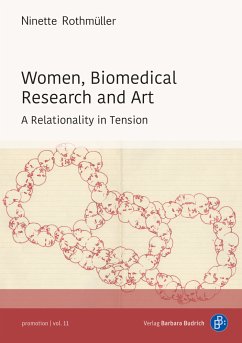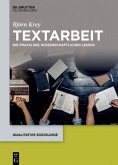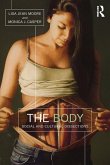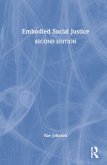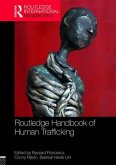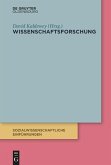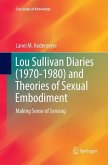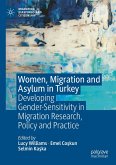Ninette RothmüllerA Relationality in Tension
Women, Biomedical Research and Art
A Relationality in Tension
Mitarbeit:Lincoln, Kelly
Ninette RothmüllerA Relationality in Tension
Women, Biomedical Research and Art
A Relationality in Tension
Mitarbeit:Lincoln, Kelly
- Broschiertes Buch
- Merkliste
- Auf die Merkliste
- Bewerten Bewerten
- Teilen
- Produkt teilen
- Produkterinnerung
- Produkterinnerung
Die Studie widmet sich intersektionalen Verletztbarkeiten, sozio-geografischen und rassistischen Ungerechtigkeiten sowie dem Traumapotenzial von Reproduktionsmedizin, Menschenhandel und Schwarzmarkt-Organhandel. Mittels eines empirischen, kritisch-diskursanalytischen, künstlerischen und philosophisch-theoretischen Zugangs entwickelt die interdisziplinäre Studie praktische kreative Werkzeuge für eine Pädagogik, die Würde und Integrität betont und die Menschenrechte im Alltag der betroffenen Bevölkerung unterstützt.
Andere Kunden interessierten sich auch für
![Textarbeit Textarbeit]() Björn KreyTextarbeit44,95 €
Björn KreyTextarbeit44,95 €![The Body The Body]() Lisa Jean MooreThe Body98,99 €
Lisa Jean MooreThe Body98,99 €![Embodied Social Justice Embodied Social Justice]() Rae JohnsonEmbodied Social Justice180,99 €
Rae JohnsonEmbodied Social Justice180,99 €![Routledge Handbook of Human Trafficking Routledge Handbook of Human Trafficking]() Routledge Handbook of Human Trafficking319,99 €
Routledge Handbook of Human Trafficking319,99 €![Wissenschaftsforschung Wissenschaftsforschung]() Wissenschaftsforschung29,95 €
Wissenschaftsforschung29,95 €![Lou Sullivan Diaries (1970-1980) and Theories of Sexual Embodiment Lou Sullivan Diaries (1970-1980) and Theories of Sexual Embodiment]() Lanei M. RodemeyerLou Sullivan Diaries (1970-1980) and Theories of Sexual Embodiment41,99 €
Lanei M. RodemeyerLou Sullivan Diaries (1970-1980) and Theories of Sexual Embodiment41,99 €![Women, Migration and Asylum in Turkey Women, Migration and Asylum in Turkey]() Women, Migration and Asylum in Turkey105,99 €
Women, Migration and Asylum in Turkey105,99 €-
-
-
Die Studie widmet sich intersektionalen Verletztbarkeiten, sozio-geografischen und rassistischen Ungerechtigkeiten sowie dem Traumapotenzial von Reproduktionsmedizin, Menschenhandel und Schwarzmarkt-Organhandel. Mittels eines empirischen, kritisch-diskursanalytischen, künstlerischen und philosophisch-theoretischen Zugangs entwickelt die interdisziplinäre Studie praktische kreative Werkzeuge für eine Pädagogik, die Würde und Integrität betont und die Menschenrechte im Alltag der betroffenen Bevölkerung unterstützt.
Hinweis: Dieser Artikel kann nur an eine deutsche Lieferadresse ausgeliefert werden.
Hinweis: Dieser Artikel kann nur an eine deutsche Lieferadresse ausgeliefert werden.
Produktdetails
- Produktdetails
- Promotion 11
- Verlag: Verlag Barbara Budrich
- Artikelnr. des Verlages: 11470
- Seitenzahl: 369
- Erscheinungstermin: 17. Juni 2021
- Englisch
- Abmessung: 21mm x 183mm x 204mm
- Gewicht: 666g
- ISBN-13: 9783847424390
- Artikelnr.: 60662559
- Herstellerkennzeichnung Die Herstellerinformationen sind derzeit nicht verfügbar.
- Promotion 11
- Verlag: Verlag Barbara Budrich
- Artikelnr. des Verlages: 11470
- Seitenzahl: 369
- Erscheinungstermin: 17. Juni 2021
- Englisch
- Abmessung: 21mm x 183mm x 204mm
- Gewicht: 666g
- ISBN-13: 9783847424390
- Artikelnr.: 60662559
- Herstellerkennzeichnung Die Herstellerinformationen sind derzeit nicht verfügbar.
Table of Content
1. Prologue
1.1 Introduction
1.1.1 Research Leading to this Study
1.1.2 Embedding my Research in Pedagogy
1.1.3 Content of Chapters
2. On the Matrix of this Study OR How to Soar
2.1 On the Interest in Messiness and Inclusion
2.2 Body/Körper and Leib - an Attempt to Define Relationality through Translation,
Time and Meaning
2.2.1 An Introduction to Spaces of Public Reflections: On Erasing and Connecting
'Semi-real' Bodies
2.2.2 On the Interface of Body/Körper and Leib - the Significance of Translations and
Relationality between Experience and Language
2.2.3 Body/Körper and Leib - Historical Connections - Philosophical and Religious
Framings
2.2.4 On the Interface of Body, Leib and Körper - Phenomenology and Post-structural
Thoughts
2.3 Body/Körper and Leib - Theory and its Application
2.3.1 On the Entwinement of Body/Körper and Leib
2.4 Leib Confrontations
3. The Methodological Conceptualization of the Project
3.1 The Pre-study
3.2 The multi-sited characteristics of this study
3.2.1 Germany and the UK as geographical, political, legal, social and cultural research
sites
3.2.2 Sites of Technological Intersections
3.2.3 Sites of Transdisciplinarity
3.3 Fieldwork
3.3.1 Feminist Ways of Knowing
3.3.2 Locating Visuals in the Field and Social Science Research
3.3.3 Carrying out Conversations
3.3.3.1 On Expert and Expertise
3.3.3.2 Locating and 'Choosing' Conversation Partners
3.3.3.2.1 On the Relationship to Theoretical Sampling
3.3.3.2.2 On the Relationship to Snowball Sampling
3.3.4 On the Shift of Talking of Conversations instead of Interviews and on the Role of
Both Conversation Partners
3.3.5 Incorporating Texts in Fieldwork
3.4 Analysis/Writing
3.4.1 Transcription and Authorization
3.4.2 On the Use of Language as an Analytical Tool
3.4.3 Art as a Tool to Research - 'Of Women'
4. Fragmentations
4.1 Entities in a Chapter about Fragmentation
4.2 Constructing potential Things in Time and Space
4.2.1 Telling the Story - Presenting the Pictures. On Trying to Grasp what is at Stake
4.2.2 Telling the Story - Sensing Women. Contributions to Confusion
4.2.3 Presenting the Picture - Sensing the Female Body. Contributions in Search of
Matter(s)
4.2.4 Preparing the Stage - On Spaces of Separation and Hierarchies
4.2.5 Seeking Company - Speaking, Writing, Seeing
4.3 Bodies at Stake - Visualized, Seduced, taken Apart, but Alive?
4.3.1 Bodies Inside out - Dwelled Space Seduced
4.3.2 The Heartbeat of a Machine and I
4.3.3 On the Organic Colonization of Scotland and England by a Pregnant Woman
4.4 Final Thoughts
5. Body Geographics. Territories, Trades and Mappings in Inequality
5.1 Body Territories under Re-construction - an Introduction
5.1.1 Body Territories under Re-construction - Voices
5.1.2 Body Territories under Re-construction - Actors and Activities
5.1.3 Bodily Substance Transfer and Hierarchies in Organ Transplantations or When
are we dead?
5.1.4 Mapping Sites in Action - On the Creation of Powerful Stories, Marketable
Events and Images
5.1.5 Art and the Skinned and Scanned Human
5.2. Traffics in the Body - Historical Remarks on Substantial Trade Relations
6. Gendered Harvest
6.1 Cells at Stake - Ethical and Legal Approaches
6. 2 Human Recycling - Terms and Conditions
6.2.1 Bodies and Borders - Voices
6.2.2 Body Exchange and Leib Rejection
6.3. Gendered 'Donations'
6.3.1 Rearranging Borders - Organs and Tissue Travel from East to West and from
Bottom to Top
6.3.2 Harvesting the Body during the Gold Rush
6.3.3 Gifts and Commodities - writing Values onto Bodies
6.3.4 Celebrating Christmas during Birth OR How to be a 'Good Citizen'
7. PaAcknowledgments
1 Prologue
1.1 Introduction
1.1.1 Research Leading to this Study
1.1.2 Embedding the Research in Pedagogy
1.1.3 Content of Chapters
2 On the Matrix of this Study OR How to Soar
2.1 On the Interest in Messiness and Inclusion
2.2 Body/Körper and Leib - an Attempt to Define Relationality
through Translation, Time, and Meaning
2.2.1 An Introduction to Spaces of Public Reflections:
On Erasing and Connecting "Semi-real" Bodies
2.2.2 On the Interface of Body/Körper and Leib -
the Significance of Translations and Relationality
between Experience and Language
2.3 Body/Körper and Leib - Historical Connections -
Philosophical and Religious Framings
2.3.1 On the Interface of Body, Leib and Körper -
Phenomenology and Post- structural Thoughts
2.4 Body/Körper and Leib - Theory and its Application
2.4.1 On the Entwinement of Body/Körper and Leib
2.5 Leib Confrontations
3 The Methodological Conceptualization of the Project
3.1 The Pre-study
3.2 The Multi-Sited Characteristics of this Study
3.2.1 Germany and the UK as Geographical, Political,
Legal, Social, and Cultural Research Sites
3.2.2 Sites of Technological Intersections
3.2.3 Sites of Transdisciplinarity
3.3 Fieldwork
3.3.1 Feminist Ways of Knowing
3.3.2 Locating Visuals in the Field and Social Science
Research
3.3.3 Carrying out Conversations
3.3.4 On the Shift to Talking of Conversations instead of
Interviews and on the Role of Both Conversation
Partners
3.3.5 Incorporating Texts in Fieldwork
3.4 Analysis/Writing
3.4.1 Transcription and Authorization
3.4.2 On the Use of Language as an Analytical Tool
3.4.3 Art as a Tool to Research - Of Women
4 Fragmentations
4.1 Entities in a Chapter about Fragmentation
4.2 Constructing Potential Things in Time and Space
4.2.1 Telling the Story - Presenting the Pictures. On Trying
to Grasp what is at Stake
4.2.2 Telling the Story - Sensing Women. Contributions
to Confusion
4.2.3 Presenting the Picture - Sensing the Female Body.
Contribution in Search of Matter(s)
4.2.4 Preparing the Stage - On Spaces of Separation and
Hierarchies
4.2.5 Seeking Company - Speaking, Writing, Seeing
4.3 Bodies at Stake - Visualized, Seduced, Taken Apart,
but Alive?
4.3.1 Bodies Inside out - Dwelled Space Seduced
4.3.2 The Heartbeat of a Machine and I
4.3.3 On the Organic Colonization of Scotland and England
by a Pregnant Woman
4.4 Final Thoughts
5 Body Geographics. Territories, Trades, and Mappings
in Inequality
5.1 Body Territories Under Re-construction - an Introduction
5.1.1 Body Territories Under Re-construction - Voices
5.1.2 Body Territories Under Re-construction -
Actors and Activities
5.1.3 Bodily Substance Transfer and Hierarchies in Organ
Transplantations or, When Are We Dead?
5.1.4 Mapping Sites in Action - On the Creation of
Powerful Stories, Marketable Events, and Images
5.1.5 Art and the Skinned and Scanned Human
5.2 Traffics in the Body - Historical Remarks on Substantial
Trade Relations
6 Gendered Harvest
6.1 Cells at Stake - Ethical and Legal Approaches
6.2 Human Recycling - Terms and Conditions
6.2.1 Bodies and Borders - Voices
6.2.2 Body Exchange and Leib Rejection
6.3 Gendered "Donations"
6.3.1 Rearranging Borders - Organs and Tissue Travel
from East to West and from Bottom to Top
6.3.2 Harvesting the Body during the Gold Rush
6.3.3 Gifts and Commodities - Writing Values
onto Bodies
6.3.4 Celebrating Christmas during Birth OR How to Be
a "Good Citizen"
7 Participatory Art and Public Engagement
7.1 To Create
7.1.1 To Create Here and Now, There and Then
7.1.2 Space, Place, Site, Location - Theore
1. Prologue
1.1 Introduction
1.1.1 Research Leading to this Study
1.1.2 Embedding my Research in Pedagogy
1.1.3 Content of Chapters
2. On the Matrix of this Study OR How to Soar
2.1 On the Interest in Messiness and Inclusion
2.2 Body/Körper and Leib - an Attempt to Define Relationality through Translation,
Time and Meaning
2.2.1 An Introduction to Spaces of Public Reflections: On Erasing and Connecting
'Semi-real' Bodies
2.2.2 On the Interface of Body/Körper and Leib - the Significance of Translations and
Relationality between Experience and Language
2.2.3 Body/Körper and Leib - Historical Connections - Philosophical and Religious
Framings
2.2.4 On the Interface of Body, Leib and Körper - Phenomenology and Post-structural
Thoughts
2.3 Body/Körper and Leib - Theory and its Application
2.3.1 On the Entwinement of Body/Körper and Leib
2.4 Leib Confrontations
3. The Methodological Conceptualization of the Project
3.1 The Pre-study
3.2 The multi-sited characteristics of this study
3.2.1 Germany and the UK as geographical, political, legal, social and cultural research
sites
3.2.2 Sites of Technological Intersections
3.2.3 Sites of Transdisciplinarity
3.3 Fieldwork
3.3.1 Feminist Ways of Knowing
3.3.2 Locating Visuals in the Field and Social Science Research
3.3.3 Carrying out Conversations
3.3.3.1 On Expert and Expertise
3.3.3.2 Locating and 'Choosing' Conversation Partners
3.3.3.2.1 On the Relationship to Theoretical Sampling
3.3.3.2.2 On the Relationship to Snowball Sampling
3.3.4 On the Shift of Talking of Conversations instead of Interviews and on the Role of
Both Conversation Partners
3.3.5 Incorporating Texts in Fieldwork
3.4 Analysis/Writing
3.4.1 Transcription and Authorization
3.4.2 On the Use of Language as an Analytical Tool
3.4.3 Art as a Tool to Research - 'Of Women'
4. Fragmentations
4.1 Entities in a Chapter about Fragmentation
4.2 Constructing potential Things in Time and Space
4.2.1 Telling the Story - Presenting the Pictures. On Trying to Grasp what is at Stake
4.2.2 Telling the Story - Sensing Women. Contributions to Confusion
4.2.3 Presenting the Picture - Sensing the Female Body. Contributions in Search of
Matter(s)
4.2.4 Preparing the Stage - On Spaces of Separation and Hierarchies
4.2.5 Seeking Company - Speaking, Writing, Seeing
4.3 Bodies at Stake - Visualized, Seduced, taken Apart, but Alive?
4.3.1 Bodies Inside out - Dwelled Space Seduced
4.3.2 The Heartbeat of a Machine and I
4.3.3 On the Organic Colonization of Scotland and England by a Pregnant Woman
4.4 Final Thoughts
5. Body Geographics. Territories, Trades and Mappings in Inequality
5.1 Body Territories under Re-construction - an Introduction
5.1.1 Body Territories under Re-construction - Voices
5.1.2 Body Territories under Re-construction - Actors and Activities
5.1.3 Bodily Substance Transfer and Hierarchies in Organ Transplantations or When
are we dead?
5.1.4 Mapping Sites in Action - On the Creation of Powerful Stories, Marketable
Events and Images
5.1.5 Art and the Skinned and Scanned Human
5.2. Traffics in the Body - Historical Remarks on Substantial Trade Relations
6. Gendered Harvest
6.1 Cells at Stake - Ethical and Legal Approaches
6. 2 Human Recycling - Terms and Conditions
6.2.1 Bodies and Borders - Voices
6.2.2 Body Exchange and Leib Rejection
6.3. Gendered 'Donations'
6.3.1 Rearranging Borders - Organs and Tissue Travel from East to West and from
Bottom to Top
6.3.2 Harvesting the Body during the Gold Rush
6.3.3 Gifts and Commodities - writing Values onto Bodies
6.3.4 Celebrating Christmas during Birth OR How to be a 'Good Citizen'
7. PaAcknowledgments
1 Prologue
1.1 Introduction
1.1.1 Research Leading to this Study
1.1.2 Embedding the Research in Pedagogy
1.1.3 Content of Chapters
2 On the Matrix of this Study OR How to Soar
2.1 On the Interest in Messiness and Inclusion
2.2 Body/Körper and Leib - an Attempt to Define Relationality
through Translation, Time, and Meaning
2.2.1 An Introduction to Spaces of Public Reflections:
On Erasing and Connecting "Semi-real" Bodies
2.2.2 On the Interface of Body/Körper and Leib -
the Significance of Translations and Relationality
between Experience and Language
2.3 Body/Körper and Leib - Historical Connections -
Philosophical and Religious Framings
2.3.1 On the Interface of Body, Leib and Körper -
Phenomenology and Post- structural Thoughts
2.4 Body/Körper and Leib - Theory and its Application
2.4.1 On the Entwinement of Body/Körper and Leib
2.5 Leib Confrontations
3 The Methodological Conceptualization of the Project
3.1 The Pre-study
3.2 The Multi-Sited Characteristics of this Study
3.2.1 Germany and the UK as Geographical, Political,
Legal, Social, and Cultural Research Sites
3.2.2 Sites of Technological Intersections
3.2.3 Sites of Transdisciplinarity
3.3 Fieldwork
3.3.1 Feminist Ways of Knowing
3.3.2 Locating Visuals in the Field and Social Science
Research
3.3.3 Carrying out Conversations
3.3.4 On the Shift to Talking of Conversations instead of
Interviews and on the Role of Both Conversation
Partners
3.3.5 Incorporating Texts in Fieldwork
3.4 Analysis/Writing
3.4.1 Transcription and Authorization
3.4.2 On the Use of Language as an Analytical Tool
3.4.3 Art as a Tool to Research - Of Women
4 Fragmentations
4.1 Entities in a Chapter about Fragmentation
4.2 Constructing Potential Things in Time and Space
4.2.1 Telling the Story - Presenting the Pictures. On Trying
to Grasp what is at Stake
4.2.2 Telling the Story - Sensing Women. Contributions
to Confusion
4.2.3 Presenting the Picture - Sensing the Female Body.
Contribution in Search of Matter(s)
4.2.4 Preparing the Stage - On Spaces of Separation and
Hierarchies
4.2.5 Seeking Company - Speaking, Writing, Seeing
4.3 Bodies at Stake - Visualized, Seduced, Taken Apart,
but Alive?
4.3.1 Bodies Inside out - Dwelled Space Seduced
4.3.2 The Heartbeat of a Machine and I
4.3.3 On the Organic Colonization of Scotland and England
by a Pregnant Woman
4.4 Final Thoughts
5 Body Geographics. Territories, Trades, and Mappings
in Inequality
5.1 Body Territories Under Re-construction - an Introduction
5.1.1 Body Territories Under Re-construction - Voices
5.1.2 Body Territories Under Re-construction -
Actors and Activities
5.1.3 Bodily Substance Transfer and Hierarchies in Organ
Transplantations or, When Are We Dead?
5.1.4 Mapping Sites in Action - On the Creation of
Powerful Stories, Marketable Events, and Images
5.1.5 Art and the Skinned and Scanned Human
5.2 Traffics in the Body - Historical Remarks on Substantial
Trade Relations
6 Gendered Harvest
6.1 Cells at Stake - Ethical and Legal Approaches
6.2 Human Recycling - Terms and Conditions
6.2.1 Bodies and Borders - Voices
6.2.2 Body Exchange and Leib Rejection
6.3 Gendered "Donations"
6.3.1 Rearranging Borders - Organs and Tissue Travel
from East to West and from Bottom to Top
6.3.2 Harvesting the Body during the Gold Rush
6.3.3 Gifts and Commodities - Writing Values
onto Bodies
6.3.4 Celebrating Christmas during Birth OR How to Be
a "Good Citizen"
7 Participatory Art and Public Engagement
7.1 To Create
7.1.1 To Create Here and Now, There and Then
7.1.2 Space, Place, Site, Location - Theore
Table of Content
1. Prologue
1.1 Introduction
1.1.1 Research Leading to this Study
1.1.2 Embedding my Research in Pedagogy
1.1.3 Content of Chapters
2. On the Matrix of this Study OR How to Soar
2.1 On the Interest in Messiness and Inclusion
2.2 Body/Körper and Leib - an Attempt to Define Relationality through Translation,
Time and Meaning
2.2.1 An Introduction to Spaces of Public Reflections: On Erasing and Connecting
'Semi-real' Bodies
2.2.2 On the Interface of Body/Körper and Leib - the Significance of Translations and
Relationality between Experience and Language
2.2.3 Body/Körper and Leib - Historical Connections - Philosophical and Religious
Framings
2.2.4 On the Interface of Body, Leib and Körper - Phenomenology and Post-structural
Thoughts
2.3 Body/Körper and Leib - Theory and its Application
2.3.1 On the Entwinement of Body/Körper and Leib
2.4 Leib Confrontations
3. The Methodological Conceptualization of the Project
3.1 The Pre-study
3.2 The multi-sited characteristics of this study
3.2.1 Germany and the UK as geographical, political, legal, social and cultural research
sites
3.2.2 Sites of Technological Intersections
3.2.3 Sites of Transdisciplinarity
3.3 Fieldwork
3.3.1 Feminist Ways of Knowing
3.3.2 Locating Visuals in the Field and Social Science Research
3.3.3 Carrying out Conversations
3.3.3.1 On Expert and Expertise
3.3.3.2 Locating and 'Choosing' Conversation Partners
3.3.3.2.1 On the Relationship to Theoretical Sampling
3.3.3.2.2 On the Relationship to Snowball Sampling
3.3.4 On the Shift of Talking of Conversations instead of Interviews and on the Role of
Both Conversation Partners
3.3.5 Incorporating Texts in Fieldwork
3.4 Analysis/Writing
3.4.1 Transcription and Authorization
3.4.2 On the Use of Language as an Analytical Tool
3.4.3 Art as a Tool to Research - 'Of Women'
4. Fragmentations
4.1 Entities in a Chapter about Fragmentation
4.2 Constructing potential Things in Time and Space
4.2.1 Telling the Story - Presenting the Pictures. On Trying to Grasp what is at Stake
4.2.2 Telling the Story - Sensing Women. Contributions to Confusion
4.2.3 Presenting the Picture - Sensing the Female Body. Contributions in Search of
Matter(s)
4.2.4 Preparing the Stage - On Spaces of Separation and Hierarchies
4.2.5 Seeking Company - Speaking, Writing, Seeing
4.3 Bodies at Stake - Visualized, Seduced, taken Apart, but Alive?
4.3.1 Bodies Inside out - Dwelled Space Seduced
4.3.2 The Heartbeat of a Machine and I
4.3.3 On the Organic Colonization of Scotland and England by a Pregnant Woman
4.4 Final Thoughts
5. Body Geographics. Territories, Trades and Mappings in Inequality
5.1 Body Territories under Re-construction - an Introduction
5.1.1 Body Territories under Re-construction - Voices
5.1.2 Body Territories under Re-construction - Actors and Activities
5.1.3 Bodily Substance Transfer and Hierarchies in Organ Transplantations or When
are we dead?
5.1.4 Mapping Sites in Action - On the Creation of Powerful Stories, Marketable
Events and Images
5.1.5 Art and the Skinned and Scanned Human
5.2. Traffics in the Body - Historical Remarks on Substantial Trade Relations
6. Gendered Harvest
6.1 Cells at Stake - Ethical and Legal Approaches
6. 2 Human Recycling - Terms and Conditions
6.2.1 Bodies and Borders - Voices
6.2.2 Body Exchange and Leib Rejection
6.3. Gendered 'Donations'
6.3.1 Rearranging Borders - Organs and Tissue Travel from East to West and from
Bottom to Top
6.3.2 Harvesting the Body during the Gold Rush
6.3.3 Gifts and Commodities - writing Values onto Bodies
6.3.4 Celebrating Christmas during Birth OR How to be a 'Good Citizen'
7. PaAcknowledgments
1 Prologue
1.1 Introduction
1.1.1 Research Leading to this Study
1.1.2 Embedding the Research in Pedagogy
1.1.3 Content of Chapters
2 On the Matrix of this Study OR How to Soar
2.1 On the Interest in Messiness and Inclusion
2.2 Body/Körper and Leib - an Attempt to Define Relationality
through Translation, Time, and Meaning
2.2.1 An Introduction to Spaces of Public Reflections:
On Erasing and Connecting "Semi-real" Bodies
2.2.2 On the Interface of Body/Körper and Leib -
the Significance of Translations and Relationality
between Experience and Language
2.3 Body/Körper and Leib - Historical Connections -
Philosophical and Religious Framings
2.3.1 On the Interface of Body, Leib and Körper -
Phenomenology and Post- structural Thoughts
2.4 Body/Körper and Leib - Theory and its Application
2.4.1 On the Entwinement of Body/Körper and Leib
2.5 Leib Confrontations
3 The Methodological Conceptualization of the Project
3.1 The Pre-study
3.2 The Multi-Sited Characteristics of this Study
3.2.1 Germany and the UK as Geographical, Political,
Legal, Social, and Cultural Research Sites
3.2.2 Sites of Technological Intersections
3.2.3 Sites of Transdisciplinarity
3.3 Fieldwork
3.3.1 Feminist Ways of Knowing
3.3.2 Locating Visuals in the Field and Social Science
Research
3.3.3 Carrying out Conversations
3.3.4 On the Shift to Talking of Conversations instead of
Interviews and on the Role of Both Conversation
Partners
3.3.5 Incorporating Texts in Fieldwork
3.4 Analysis/Writing
3.4.1 Transcription and Authorization
3.4.2 On the Use of Language as an Analytical Tool
3.4.3 Art as a Tool to Research - Of Women
4 Fragmentations
4.1 Entities in a Chapter about Fragmentation
4.2 Constructing Potential Things in Time and Space
4.2.1 Telling the Story - Presenting the Pictures. On Trying
to Grasp what is at Stake
4.2.2 Telling the Story - Sensing Women. Contributions
to Confusion
4.2.3 Presenting the Picture - Sensing the Female Body.
Contribution in Search of Matter(s)
4.2.4 Preparing the Stage - On Spaces of Separation and
Hierarchies
4.2.5 Seeking Company - Speaking, Writing, Seeing
4.3 Bodies at Stake - Visualized, Seduced, Taken Apart,
but Alive?
4.3.1 Bodies Inside out - Dwelled Space Seduced
4.3.2 The Heartbeat of a Machine and I
4.3.3 On the Organic Colonization of Scotland and England
by a Pregnant Woman
4.4 Final Thoughts
5 Body Geographics. Territories, Trades, and Mappings
in Inequality
5.1 Body Territories Under Re-construction - an Introduction
5.1.1 Body Territories Under Re-construction - Voices
5.1.2 Body Territories Under Re-construction -
Actors and Activities
5.1.3 Bodily Substance Transfer and Hierarchies in Organ
Transplantations or, When Are We Dead?
5.1.4 Mapping Sites in Action - On the Creation of
Powerful Stories, Marketable Events, and Images
5.1.5 Art and the Skinned and Scanned Human
5.2 Traffics in the Body - Historical Remarks on Substantial
Trade Relations
6 Gendered Harvest
6.1 Cells at Stake - Ethical and Legal Approaches
6.2 Human Recycling - Terms and Conditions
6.2.1 Bodies and Borders - Voices
6.2.2 Body Exchange and Leib Rejection
6.3 Gendered "Donations"
6.3.1 Rearranging Borders - Organs and Tissue Travel
from East to West and from Bottom to Top
6.3.2 Harvesting the Body during the Gold Rush
6.3.3 Gifts and Commodities - Writing Values
onto Bodies
6.3.4 Celebrating Christmas during Birth OR How to Be
a "Good Citizen"
7 Participatory Art and Public Engagement
7.1 To Create
7.1.1 To Create Here and Now, There and Then
7.1.2 Space, Place, Site, Location - Theore
1. Prologue
1.1 Introduction
1.1.1 Research Leading to this Study
1.1.2 Embedding my Research in Pedagogy
1.1.3 Content of Chapters
2. On the Matrix of this Study OR How to Soar
2.1 On the Interest in Messiness and Inclusion
2.2 Body/Körper and Leib - an Attempt to Define Relationality through Translation,
Time and Meaning
2.2.1 An Introduction to Spaces of Public Reflections: On Erasing and Connecting
'Semi-real' Bodies
2.2.2 On the Interface of Body/Körper and Leib - the Significance of Translations and
Relationality between Experience and Language
2.2.3 Body/Körper and Leib - Historical Connections - Philosophical and Religious
Framings
2.2.4 On the Interface of Body, Leib and Körper - Phenomenology and Post-structural
Thoughts
2.3 Body/Körper and Leib - Theory and its Application
2.3.1 On the Entwinement of Body/Körper and Leib
2.4 Leib Confrontations
3. The Methodological Conceptualization of the Project
3.1 The Pre-study
3.2 The multi-sited characteristics of this study
3.2.1 Germany and the UK as geographical, political, legal, social and cultural research
sites
3.2.2 Sites of Technological Intersections
3.2.3 Sites of Transdisciplinarity
3.3 Fieldwork
3.3.1 Feminist Ways of Knowing
3.3.2 Locating Visuals in the Field and Social Science Research
3.3.3 Carrying out Conversations
3.3.3.1 On Expert and Expertise
3.3.3.2 Locating and 'Choosing' Conversation Partners
3.3.3.2.1 On the Relationship to Theoretical Sampling
3.3.3.2.2 On the Relationship to Snowball Sampling
3.3.4 On the Shift of Talking of Conversations instead of Interviews and on the Role of
Both Conversation Partners
3.3.5 Incorporating Texts in Fieldwork
3.4 Analysis/Writing
3.4.1 Transcription and Authorization
3.4.2 On the Use of Language as an Analytical Tool
3.4.3 Art as a Tool to Research - 'Of Women'
4. Fragmentations
4.1 Entities in a Chapter about Fragmentation
4.2 Constructing potential Things in Time and Space
4.2.1 Telling the Story - Presenting the Pictures. On Trying to Grasp what is at Stake
4.2.2 Telling the Story - Sensing Women. Contributions to Confusion
4.2.3 Presenting the Picture - Sensing the Female Body. Contributions in Search of
Matter(s)
4.2.4 Preparing the Stage - On Spaces of Separation and Hierarchies
4.2.5 Seeking Company - Speaking, Writing, Seeing
4.3 Bodies at Stake - Visualized, Seduced, taken Apart, but Alive?
4.3.1 Bodies Inside out - Dwelled Space Seduced
4.3.2 The Heartbeat of a Machine and I
4.3.3 On the Organic Colonization of Scotland and England by a Pregnant Woman
4.4 Final Thoughts
5. Body Geographics. Territories, Trades and Mappings in Inequality
5.1 Body Territories under Re-construction - an Introduction
5.1.1 Body Territories under Re-construction - Voices
5.1.2 Body Territories under Re-construction - Actors and Activities
5.1.3 Bodily Substance Transfer and Hierarchies in Organ Transplantations or When
are we dead?
5.1.4 Mapping Sites in Action - On the Creation of Powerful Stories, Marketable
Events and Images
5.1.5 Art and the Skinned and Scanned Human
5.2. Traffics in the Body - Historical Remarks on Substantial Trade Relations
6. Gendered Harvest
6.1 Cells at Stake - Ethical and Legal Approaches
6. 2 Human Recycling - Terms and Conditions
6.2.1 Bodies and Borders - Voices
6.2.2 Body Exchange and Leib Rejection
6.3. Gendered 'Donations'
6.3.1 Rearranging Borders - Organs and Tissue Travel from East to West and from
Bottom to Top
6.3.2 Harvesting the Body during the Gold Rush
6.3.3 Gifts and Commodities - writing Values onto Bodies
6.3.4 Celebrating Christmas during Birth OR How to be a 'Good Citizen'
7. PaAcknowledgments
1 Prologue
1.1 Introduction
1.1.1 Research Leading to this Study
1.1.2 Embedding the Research in Pedagogy
1.1.3 Content of Chapters
2 On the Matrix of this Study OR How to Soar
2.1 On the Interest in Messiness and Inclusion
2.2 Body/Körper and Leib - an Attempt to Define Relationality
through Translation, Time, and Meaning
2.2.1 An Introduction to Spaces of Public Reflections:
On Erasing and Connecting "Semi-real" Bodies
2.2.2 On the Interface of Body/Körper and Leib -
the Significance of Translations and Relationality
between Experience and Language
2.3 Body/Körper and Leib - Historical Connections -
Philosophical and Religious Framings
2.3.1 On the Interface of Body, Leib and Körper -
Phenomenology and Post- structural Thoughts
2.4 Body/Körper and Leib - Theory and its Application
2.4.1 On the Entwinement of Body/Körper and Leib
2.5 Leib Confrontations
3 The Methodological Conceptualization of the Project
3.1 The Pre-study
3.2 The Multi-Sited Characteristics of this Study
3.2.1 Germany and the UK as Geographical, Political,
Legal, Social, and Cultural Research Sites
3.2.2 Sites of Technological Intersections
3.2.3 Sites of Transdisciplinarity
3.3 Fieldwork
3.3.1 Feminist Ways of Knowing
3.3.2 Locating Visuals in the Field and Social Science
Research
3.3.3 Carrying out Conversations
3.3.4 On the Shift to Talking of Conversations instead of
Interviews and on the Role of Both Conversation
Partners
3.3.5 Incorporating Texts in Fieldwork
3.4 Analysis/Writing
3.4.1 Transcription and Authorization
3.4.2 On the Use of Language as an Analytical Tool
3.4.3 Art as a Tool to Research - Of Women
4 Fragmentations
4.1 Entities in a Chapter about Fragmentation
4.2 Constructing Potential Things in Time and Space
4.2.1 Telling the Story - Presenting the Pictures. On Trying
to Grasp what is at Stake
4.2.2 Telling the Story - Sensing Women. Contributions
to Confusion
4.2.3 Presenting the Picture - Sensing the Female Body.
Contribution in Search of Matter(s)
4.2.4 Preparing the Stage - On Spaces of Separation and
Hierarchies
4.2.5 Seeking Company - Speaking, Writing, Seeing
4.3 Bodies at Stake - Visualized, Seduced, Taken Apart,
but Alive?
4.3.1 Bodies Inside out - Dwelled Space Seduced
4.3.2 The Heartbeat of a Machine and I
4.3.3 On the Organic Colonization of Scotland and England
by a Pregnant Woman
4.4 Final Thoughts
5 Body Geographics. Territories, Trades, and Mappings
in Inequality
5.1 Body Territories Under Re-construction - an Introduction
5.1.1 Body Territories Under Re-construction - Voices
5.1.2 Body Territories Under Re-construction -
Actors and Activities
5.1.3 Bodily Substance Transfer and Hierarchies in Organ
Transplantations or, When Are We Dead?
5.1.4 Mapping Sites in Action - On the Creation of
Powerful Stories, Marketable Events, and Images
5.1.5 Art and the Skinned and Scanned Human
5.2 Traffics in the Body - Historical Remarks on Substantial
Trade Relations
6 Gendered Harvest
6.1 Cells at Stake - Ethical and Legal Approaches
6.2 Human Recycling - Terms and Conditions
6.2.1 Bodies and Borders - Voices
6.2.2 Body Exchange and Leib Rejection
6.3 Gendered "Donations"
6.3.1 Rearranging Borders - Organs and Tissue Travel
from East to West and from Bottom to Top
6.3.2 Harvesting the Body during the Gold Rush
6.3.3 Gifts and Commodities - Writing Values
onto Bodies
6.3.4 Celebrating Christmas during Birth OR How to Be
a "Good Citizen"
7 Participatory Art and Public Engagement
7.1 To Create
7.1.1 To Create Here and Now, There and Then
7.1.2 Space, Place, Site, Location - Theore

